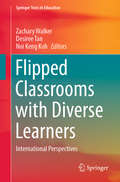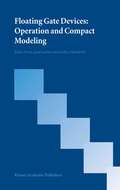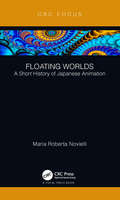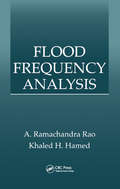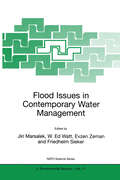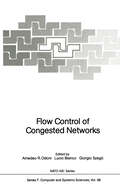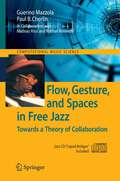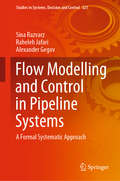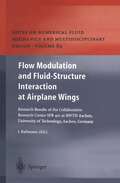- Table View
- List View
Flight Systems and Control: A Practical Approach (Springer Aerospace Technology)
by Tian Seng NgThis book focuses on flight vehicles and their navigational systems, discussing different forms of flight structures and their control systems, from fixed wings to rotary crafts. Software simulation enables testing of the hardware without actual implementation, and the flight simulators, mechanics, glider development and navigation systems presented here are suitable for lab-based experimentation studies. It explores laboratory testing of flight navigational sensors, such as the magnetic, acceleration and Global Positioning System (GPS) units, and illustrates the six-axis inertial measurement unit (IMU) instrumentation as well as its data acquisition methodology. The book offers an introduction to the various unmanned aerial vehicle (UAV) systems and their accessories, including the linear quadratic regulator (LQR) method for controlling the rotorcraft. It also describes a Matrix Laboratory (MATLAB) control algorithm that simulates and runs the lab-based 3 degrees of freedom (DOF) helicopter, as well as LabVIEW software used to validate controller design and data acquisition. Lastly, the book explores future developments in aviation techniques.
Flinovia—Flow Induced Noise and Vibration Issues and Aspects-III
by Elena Ciappi Sergio De Rosa Francesco Franco Stephen A. Hambric Randolph C. K. Leung Vincent Clair Laurent Maxit Nicolas TotaroThis volume gathers the latest advances and innovations in the field of flow-induced vibration and noise, as presented by leading international researchers at the 3rd International Symposium on Flow Induced Noise and Vibration Issues and Aspects (FLINOVIA), which was held in Lyon, France, in September 2019. It explores topics such as turbulent boundary layer-induced vibration and noise, tonal noise, noise due to ingested turbulence, fluid-structure interaction problems, and noise control techniques. The authors’ backgrounds represent a mix of academia, government, and industry, and several papers include applications to important problems for underwater vehicles, aerospace structures and commercial transportation. The book offers a valuable reference guide for all those interested in measurement, modelling, simulation and reproduction of the flow excitation and flow induced structural response.
Flip-Flop Design in Nanometer CMOS: From High Speed to Low Energy
by Massimo Alioto Elio Consoli Gaetano PalumboThis book provides a unified treatment of Flip-Flop design and selection in nanometer CMOS VLSI systems. The design aspects related to the energy-delay tradeoff in Flip-Flops are discussed, including their energy-optimal selection according to the targeted application, and the detailed circuit design in nanometer CMOS VLSI systems. Design strategies are derived in a coherent framework that includes explicitly nanometer effects, including leakage, layout parasitics and process/voltage/temperature variations, as main advances over the existing body of work in the field. The related design tradeoffs are explored in a wide range of applications and the related energy-performance targets. A wide range of existing and recently proposed Flip-Flop topologies are discussed. Theoretical foundations are provided to set the stage for the derivation of design guidelines, and emphasis is given on practical aspects and consequences of the presented results. Analytical models and derivations are introduced when needed to gain an insight into the inter-dependence of design parameters under practical constraints. This book serves as a valuable reference for practicing engineers working in the VLSI design area, and as text book for senior undergraduate, graduate and postgraduate students (already familiar with digital circuits and timing).
Flipped Classrooms for Legal Education (SpringerBriefs in Law)
by Lutz-Christian Wolff Jenny ChanThis book discusses comprehensively the use of Flipped Classrooms in the context of legal education. The Flipped Classroom model implies that lecture modules are delivered online to provide more time for in-class interactivity. This book analyses the pedagogical viability, costs and other resource-related implications, technical aspects as well as the production and online distribution of Flipped Classrooms. It compares the Flipped Classroom concept with traditional law teaching methods and details its advantages and limitations. The findings are tested by way of a case study which serves as the basis for the development of comprehensive guidelines for the concept’s practical implementation. As Flipped Classrooms have become a very hot topic across disciplines in recent years, this book offers a unique resource for law teachers, law school managers as well as researchers in the field of legal education. It is a must-have for anyone interested in innovative law teaching methodologies.
Flipped Classrooms with Diverse Learners: International Perspectives (Springer Texts in Education)
by Noi Keng Koh Zachary Walker Desiree TanThis book addresses the background of classroom flipping, explores the theoretical underpinnings for why flipping works, and shares current success stories in practice. It provides diverse international examples of classroom flipping for all ages, includes discussions of the authors’ studies in the context of the existing research, and illustrates the impact that classroom flipping has had across a range of educational settings instead of focusing on a specific domain or learner context. Intended as a handbook for practitioners, the analysis of commonly used, highly effective techniques for learners of various ages fills a major gap in the literature. It offers a valuable resource for educators, helping them make the flipped learning experience an impactful and meaningful one.
The Flipped College Classroom: Conceptualized and Re-Conceptualized (Educational Communications and Technology: Issues and Innovations)
by Lucy Santos Green Jennifer R. Banas Ross A. PerkinsThis book provides a descriptive, progressive narrative on the flipped classroom including its history, connection to theory, structure, and strategies for implementation. Important questions to consider when evaluating the purpose and effectiveness of flipping are answered. The book also highlights case studies of flipped higher education classrooms within five different subject areas. Each case study is similarly structured to highlight the reasons behind flipping, principles guiding flipped instructions, strategies used, and lessons learned. An appendix that contains lesson plans, course schedules, and descriptions of specific activities is also included.
Flipping the College Classroom: An Evidence-Based Guide
by Patricia V. RoehlingFlipped learning—in which students view recorded lectures outside of the classroom and then utilize class time to develop a broad range of knowledge and skills—is a relatively new phenomenon. This timely volume examines and organizes the emerging research on flipped learning in higher education. It identifies the types of courses, material, and learning objectives that are most effectively flipped, with specialized advice for faculty in STEM fields, the social sciences, and humanities. The book also provides evidence-based guidance on how to create and disseminate engaging recorded lectures; develop and implement in-class exercises and projects that help students meet learning objectives; orient students to the flipped classroom; and assess the effectiveness of flipped learning.
Flipping the College Classroom: An Evidence-Based Guide
by Patricia V. RoehlingFlipped learning—in which students view recorded lectures outside of the classroom and then utilize class time to develop a broad range of knowledge and skills—is a relatively new phenomenon. This timely volume examines and organizes the emerging research on flipped learning in higher education. It identifies the types of courses, material, and learning objectives that are most effectively flipped, with specialized advice for faculty in STEM fields, the social sciences, and humanities. The book also provides evidence-based guidance on how to create and disseminate engaging recorded lectures; develop and implement in-class exercises and projects that help students meet learning objectives; orient students to the flipped classroom; and assess the effectiveness of flipped learning.
Flipping Your English Class to Reach All Learners: Strategies and Lesson Plans
by Troy CockrumLearn how flipping your English language arts classroom can help you reach students of different abilities, improve classroom management, and give you more time to interact with each student. This practical book shows why flipped classrooms are effective and how they work. You will find out how to flip your instruction in writing, reading, language, and speaking and listening while meeting the Common Core State Standards. A variety of step-by-step lesson plans are provided.
Flipping Your English Class to Reach All Learners: Strategies and Lesson Plans
by Troy CockrumLearn how flipping your English language arts classroom can help you reach students of different abilities, improve classroom management, and give you more time to interact with each student. This practical book shows why flipped classrooms are effective and how they work. You will find out how to flip your instruction in writing, reading, language, and speaking and listening while meeting the Common Core State Standards. A variety of step-by-step lesson plans are provided.
Floating Gate Devices: Operation and Compact Modeling
by Paolo Pavan Luca Larcher Andrea MarmiroliFloating Gate Devices: Operation and Compact Modeling focuses on standard operations and compact modeling of memory devices based on Floating Gate architecture. Floating Gate devices are the building blocks of Flash, EPROM, EEPROM memories. Flash memories, which are the most versatile nonvolatile memories, are widely used to store code (BIOS, Communication protocol, Identification code,) and data (solid-state Hard Disks, Flash cards for digital cameras,). The reader, who deals with Floating Gate memory devices at different levels - from test-structures to complex circuit design - will find an essential explanation on device physics and technology, and also circuit issues which must be fully understood while developing a new device. Device engineers will use this book to find simplified models to design new process steps or new architectures. Circuit designers will find the basic theory to understand the use of compact models to validate circuits against process variations and to evaluate the impact of parameter variations on circuit performances. Floating Gate Devices: Operation and Compact Modeling is meant to be a basic tool for designing the next generation of memory devices based on FG technologies.
Floating Worlds: A Short History of Japanese Animation (Focus Animation Ser.)
by Maria Roberta NovielliThrough the analysis of the work of the main Japanese animators starting from the pioneers of 1917, the book will overview the whole history of Japanese animated film, including the latest tendencies and the experimental movies. In addition to some of the most acclaimed directors Miyazaki Hayao, Takahata Isao, Shinkai Makoto, Tezuka Osamu and Kon Satoshi, the works of masters of animation such as Kawamoto Kihachirō, Kuri Yōji, Ōfuji Noburō and Yamamura Kōji will be analysed in their cultural and historical context. Moreover, their themes and styles will be the linking thread to overview the Japanese producing system and the social and political events which have often influenced their works. Key Features Insight into both mainstream and independent cinema Scientific reliability Easy readability Social and cultural context
Floating Worlds: A Short History of Japanese Animation (Focus Animation Ser.)
by Maria Roberta NovielliThrough the analysis of the work of the main Japanese animators starting from the pioneers of 1917, the book will overview the whole history of Japanese animated film, including the latest tendencies and the experimental movies. In addition to some of the most acclaimed directors Miyazaki Hayao, Takahata Isao, Shinkai Makoto, Tezuka Osamu and Kon Satoshi, the works of masters of animation such as Kawamoto Kihachirō, Kuri Yōji, Ōfuji Noburō and Yamamura Kōji will be analysed in their cultural and historical context. Moreover, their themes and styles will be the linking thread to overview the Japanese producing system and the social and political events which have often influenced their works. Key Features Insight into both mainstream and independent cinema Scientific reliability Easy readability Social and cultural context
Flood Frequency Analysis
by A. Ramachandra Rao and Khaled H. HamedAfter five decades, the field of Statistical Hydrology continues to evolve and remains a very active area of investigation. Researchers continue to examine various distributions, methods of estimation of parameters, and problems related to regionalization. However, much of this research appears in journals and reports and usually in a form not easi
Flood Frequency Analysis
by Khaled Hamed A. Ramachandro RaoAfter five decades, the field of Statistical Hydrology continues to evolve and remains a very active area of investigation. Researchers continue to examine various distributions, methods of estimation of parameters, and problems related to regionalization. However, much of this research appears in journals and reports and usually in a form not easi
Flood Issues in Contemporary Water Management (NATO Science Partnership Subseries: 2 #71)
by Jiri MarsalekIn 1997 disastrous flooding running through the Czech Republic, Poland, Germany took the lives of a great number of people and caused economic damage estimated in tens of billions of dollars. Flooding of the Yangtze river in 1998 killed more than 3000 people, dislocated 230 million souls, and caused direct damage of more than $ 45 billion. Both the general public and the experts are asking what we can learn from these recent events to reduce loss of life and flood damage. The 1997 floods were dealt with by experts from the Czech Republic, Poland and Germany, who presented timely reports on combatting floods, both success stories and shortcomings. This experience is further extended by reports from experts drawn from 13 other countries, developing a broad overview of flood risk management, covering the ecosystem approach to flood management, including socioeconomic issues, flood impacts on water quality, human health, and natural ecosystems.
Floppy Disk (large print)
by RnibThis is a labelled image of a floppy disk, used for storing data in a digital form. It is seen from above (seen from the side it is approximately three millimetres thick). There is a locator dot shown, which will be at the top left of the page when the image is the right way up. The image of the floppy disk is in the middle of the page. The actual magnetic disk is not visible, as it is inside a protective plastic case. At the top is a metal cover that slides to the left to reveal a window giving access to the disk inside. At the bottom of the image is a label to list the contents of the disk, and at the bottom left is a small sliding tab that can disable writing to the disk.
Floppy Disk (UEB contracted)
by RnibThis is a labelled image of a floppy disk, used for storing data in a digital form. It is seen from above (seen from the side it is approximately three millimetres thick). There is a locator dot shown, which will be at the top left of the page when the image is the right way up. The image of the floppy disk is in the middle of the page. The actual magnetic disk is not visible, as it is inside a protective plastic case. At the top is a metal cover that slides to the left to reveal a window giving access to the disk inside. At the bottom of the image is a label to list the contents of the disk, and at the bottom left is a small sliding tab that can disable writing to the disk.
Floppy Disk (UEB uncontracted)
by RnibThis is a labelled image of a floppy disk, used for storing data in a digital form. It is seen from above (seen from the side it is approximately three millimetres thick). There is a locator dot shown, which will be at the top left of the page when the image is the right way up. The image of the floppy disk is in the middle of the page. The actual magnetic disk is not visible, as it is inside a protective plastic case. At the top is a metal cover that slides to the left to reveal a window giving access to the disk inside. At the bottom of the image is a label to list the contents of the disk, and at the bottom left is a small sliding tab that can disable writing to the disk.
Flora Fantastic: From Orchidelirium to Ecocritical Contemporary Art (ISSN)
by Corina L. Apostol Tashima ThomasThis book delves deep into colonial botany, utilizing mediums such as historical investigation, cinema, photography, live performance, and installation art.Surveying perspectives from Europe, the U.S., Africa, Southeast Asia, Latin America, and the Caribbean, it positions plants—both native and foreign—as active participants and silent observers in colonial narratives. By viewing through the prism of visual and performance art, this book touches on diverse topics like the economic value of plants, traditional and Western medicine, state‑endorsed scientific endeavors, migration patterns of flora and people, bio‑contact areas, nationalistic views, and botanical diplomacy. It offers fresh insights into colonial botany’s multifaceted history, emphasizing the intricate interplay between Eastern, Western, and Southern nations during the twentieth century and its enduring impact today.Serving as an invaluable addition to the realms of art history, performance studies, botany, visual culture, decolonial initiatives, and environmental politics, this book arrives at a pivotal moment when its insights are most crucial.
Flora Fantastic: From Orchidelirium to Ecocritical Contemporary Art (ISSN)
by Tashima Thomas Corina ApostolThis book delves deep into colonial botany, utilizing mediums such as historical investigation, cinema, photography, live performance, and installation art.Surveying perspectives from Europe, the U.S., Africa, Southeast Asia, Latin America, and the Caribbean, it positions plants—both native and foreign—as active participants and silent observers in colonial narratives. By viewing through the prism of visual and performance art, this book touches on diverse topics like the economic value of plants, traditional and Western medicine, state‑endorsed scientific endeavors, migration patterns of flora and people, bio‑contact areas, nationalistic views, and botanical diplomacy. It offers fresh insights into colonial botany’s multifaceted history, emphasizing the intricate interplay between Eastern, Western, and Southern nations during the twentieth century and its enduring impact today.Serving as an invaluable addition to the realms of art history, performance studies, botany, visual culture, decolonial initiatives, and environmental politics, this book arrives at a pivotal moment when its insights are most crucial.
Flow Control of Congested Networks (NATO ASI Subseries F: #38)
by Amedeo R. Odoni Lucio Bianco Giorgio SzegöThis volume is a compendium of papers presented during the NATO Workshop which took place in Capri, Italy, October 12-18, 1986 on the general subject of "Flow Control of Congested Networks: The Case of Data Processing and Transportation", and of which we acted as co-chairmen. The focus of the workshop was on flow control methodologies, as applied to preventing or reducing congestion on: (1) data communication networks; (2) urban transportation networks; and (3) air traffic control systems. The goals of the workshop included: review of the state-of-the-art of flow control methodologies, in general, and in each of the three application areas; identification of similarities and differences in the objective functions, modeling approaches and mathematics used in the three areas; examination of opportunities for "technology transfers" and for future interactions among researchers in the three areaso These goals were pursued through individual presentations of papers on current research by workshop participants and, in the cases of the second and third goals, through a number of open-ended discussion and-review sessions which were interspersed throughout the workshop's programmeD The full texts or extended summaries of all but a few of the papers given at the workshop are included in this volume.
Flow, Gesture, and Spaces in Free Jazz: Towards a Theory of Collaboration (Computational Music Science)
by Guerino Mazzola Paul B. CherlinFlow Modelling and Control in Pipeline Systems: A Formal Systematic Approach (Studies in Systems, Decision and Control #321)
by Sina Razvarz Raheleh Jafari Alexander GegovThis book introduces novel methods for leak and blockage detection in pipelines. The leak happens as a result of ageing pipelines or extreme pressure forced by operational error or valve rapid variation. Many factors influence blockage formation in pipes like wax deposition that leads to the formation and eventual growth of solid layers and deposition of suspended solid particles in the fluids. In this book, initially, different categories of leak detection are overviewed. Afterwards, the observability and controllability of pipeline systems are analysed. Control variables can be usually presented by pressure and flow rates at the start and end points of the pipe. Different cases are considered based on the selection of control variables to model the system. Several theorems are presented to test the observability and controllability of the system. In this book, the leakage flow in the pipelines is studied numerically to find the relationship between leakage flow and pressure difference. Removing leakage completely is almost impossible; hence, the development of a formal systematic leakage control policy is the most reliable approach to reducing leakage rates.
Flow Modulation and Fluid—Structure Interaction at Airplane Wings: Research Results of the Collaborative Research Center SFB 401 at RWTH Aachen, University of Technology, Aachen, Germany (Notes on Numerical Fluid Mechanics and Multidisciplinary Design #84)
by Josef BallmannThe research work of the collaborative research center SFB401 Flow Modulation and Fluid-Structure Interaction at Airplane Wings at the Rheinisch-Westfälische Technische Hochschule (RWTH) Aachen, which is reported in this book, was pos sible due to the financial support of the Deutsche Forschungsgemeinschaft (DFG). The proposal has been approved after evaluation by the referees of DFG selected from other universities and industry, which is gratefully acknowledged. The work is still in progress and now approved to continue until the end of year 2005. More than 50 scientists from universities of the United States, Russia, France, Italy, Japan, Great Britain, Sweden, Netherlands, Switzerland, Austria and research orga nizations NASA, ONERA, NLR, DLR could be invited and have visited the research center, gave seminars on their research on related topics and some of them stayed longer for joined work. Besides its scientific value, also the importance of the pro gram for scientific educa tion becomes evident by looking at the numbers of completed theses, which are up to now about 15 doctoral theses, 40 diploma theses and 70 study theses. The authors of this book acknowledge the valuable support coming from all these persons and institutions. They are especially grateful to the referees having reviewed this work, A. Cohen (Universite Pierre et Marie Curie), J. Cooper (Manchester School of Engineering), W. Devenport (Virginia Tech.), M. Drela (MIT), F. Gern (Avionics Specialties Inc.), A. Griewank (TU Dresden), H. Hönlinger (DLR), P.




